The Timeless Charm of Ceramic Solar Bird Bath Fountains
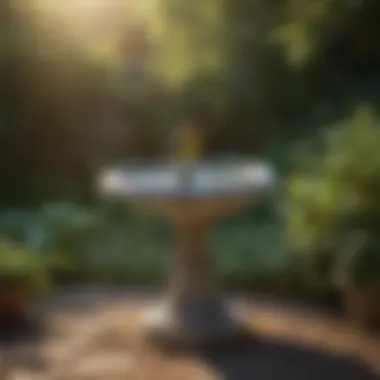
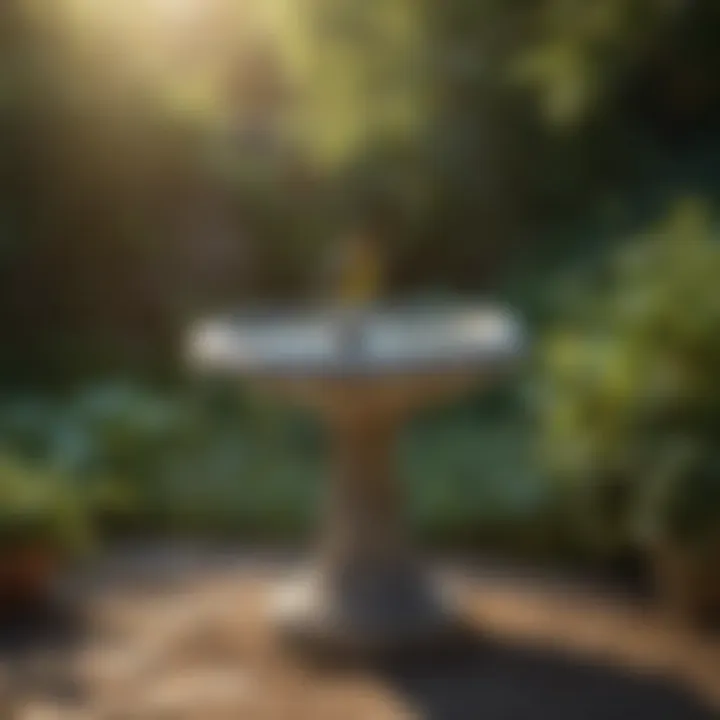
Intro
Ceramic solar bird bath fountains possess a unique charm that can transform any garden or outdoor space into a serene haven. These fountains are not only beautiful to behold but also serve multiple functional purposes. Their role extends beyond mere aesthetics; they splash life into tranquil corners and attract feathered visitors to your garden.
In the unfolding sections of this piece, we will delve into the different aspects that contribute to the allure of these installations. We’ll cover trending styles that appeal to various tastes, explore color palettes that enhance their beauty, and highlight the advantages they bring to gardens and wildlife. It's like adding a piece of art that sings nature's praises.
Trending Styles
Modern Minimalism
In recent years, modern minimalism has captured the hearts of many garden enthusiasts. This style emphasizes simplicity and functionality. Ceramic solar bird bath fountains crafted in sleek, geometrical shapes and smooth finishes embody this very essence. The clean lines and understated elegance make a statement without shouting for attention. They tend to blend seamlessly into contemporary landscapes, reinforcing the notion that less is often more.
- Material Selection: Choosing high-quality ceramic that offers durability while maintaining a refined look.
- Functional Design: Features like integrated solar panels eliminate the need for external power sources, making them eco-friendly.
Cozy Rustic
On the flip side, cozy rustic styles evoke warmth and nostalgia. These fountains might feature intricate designs, earthy tones, and textured surfaces that remind one of traditional country gardens. The feeling of stepping into a woodland retreat can be encapsulated in a quaint ceramic bird bath adorned with rustic motifs.
A few notable characteristics include:
- Hand-painted Details: Many rustic-style fountains showcase artisan craftsmanship, adding uniqueness.
- Natural Elements: Designs that reflect nature, such as leaf patterns, can draw wildlife, enhancing the connection with the outdoors.
Color Palettes
Calming Neutrals
When it comes to colors, calming neutrals often steal the limelight. Shades like soft beige, gentle gray, and muted whites provide a grounding effect in a garden setting. These colors create a tranquil ambiance where the focus shifts towards the birds and nature around. A neutral-colored ceramic fountain can complement diverse plantings, allowing the overall composition to breathe.
- Interaction with Light: Neutrals reflect sunlight beautifully, creating a serene glow when the water cascades.
- Versatility: These shades work wonderfully across different seasons, blending with spring blooms or autumn foliage.
Bold Accents
For those who seek to make a statement, bold accents might be the way to go. Eye-catching colors like deep greens, bright oranges, or vivid blues can serve as focal points. A ceramic fountain splashed with vibrant shades can breathe life into any dull spot and draw in visitors, both human and avian.
- Expressive Designs: Designs that express artistic interpretations can add personality to your garden.
- Attracting Wildlife: Brightly colored fountains can attract more birds by visually stimulating them, drawing their attention amidst greenery.
"A garden is not just a collection of plants, it's a living tapestry that tells a story through style and color."
In selecting a ceramic solar bird bath fountain, one must consider both design and color. Factors like how these elements will harmonize with the existing garden layout matter significantly. As we navigate further into the article, we'll discuss the practical benefits and considerations of integrating these fountains into your outdoor space, ensuring your sanctuary resonates with nature and beauty.
Understanding Ceramic Solar Bird Bath Fountains
The appeal of ceramic solar bird bath fountains stretches beyond their aesthetic charm. These installations provide more than just a decorative touch; they merge functionality with visual artistry while contributing positively to the environment. In this section, we will navigate through the notable attributes that define these fountains, consisting of their definitions, significance, and historical context.
Definition and Overview
Ceramic solar bird bath fountains serve as delightful features in gardens, particularly for those who wish to enhance their outdoor spaces. At their core, these fountains combine a bird bath with a water feature and are powered by solar energy. This eco-friendly dynamic ensures they require no electricity, reducing energy costs while promoting sustainability. The design typically incorporates ceramic materials, valued for their durability and ability to hold a variety of shapes and colors, giving homeowners a plethora of choices that cater to their tastes and gardens.
With their gentle water flow, they create soothing sounds that enrich the atmosphere. Birds are attracted to these installations, making them even more appealing for nature lovers. Furthermore, the presence of a working fountain and bird bath can increase the biodiversity in a garden, providing not just a safety zone for birds but also support for other small wildlife.
As more people aim to establish beautiful, lush gardens, the inclusion of a solar bird bath fountain becomes increasingly crucial—it represents a blend of nature and art.
Historical Context
The fascination with bird baths can be traced back to ancient civilizations. Historically, fountains, including those made of ceramic, have been a part of cultural and architectural traditions across the globe. From the opulent gardens of ancient Rome to the enchanting landscapes of China, bird baths served not merely functional roles but were esteemed as symbols of abundance and tranquility.
Ceramic, as a material, has also stood the test of time. For centuries, artisans have excelled in crafting intricate pottery. Each piece often reflects cultural artistry, from Mediterranean designs to the glossy finishes indicative of East Asian heritage.
As society advanced, technological differences in water management began to evolve. The advent of solar power, although a recent phenomenon, revolutionized how resources are utilized in gardens. Solar bird bath fountains marry the rich history of ceramics with modern sustainable practices, allowing homeowners to enjoy the beauty of nature while being environmentally conscious.
Ultimately, understanding the background and definitions of ceramic solar bird bath fountains establishes a foundation for appreciating their ongoing relevance in contemporary gardening.
The Aesthetic Appeal
The aesthetic appeal of ceramic solar bird bath fountains lies not just in their appearance, but in the way they transform outdoor spaces into serene, inviting environments. These installations serve as focal points in gardens, combining art and function seamlessly. With their intricate designs and beautiful finishes, they speak to both the eye and the soul, making them a cherished addition for homeowners.
Design Variations
Ceramic bird bath fountains come in a myriad of designs, each tailored to different tastes and preferences. From traditional to contemporary styles, the variations are endless. Some may lean towards elegant, classic shapes that evoke a sense of vintage charm, while others might opt for modern minimalist designs that fuse simplicity with sophistication. This diversity means that home gardeners can select a piece that resonates with their personal style.
Moreover, the architectural features in various designs can dictate not only the fountain's visual appeal but also its functionality. For example, tiered designs can facilitate water balance and movement, creating a gentle trickle sound that adds to the ambiance. In contrast, single-bowl shapes might suit those who prefer cleaner lines and a more straightforward aesthetic.
Color Options and Glazes
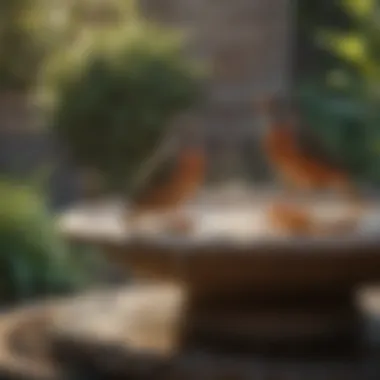
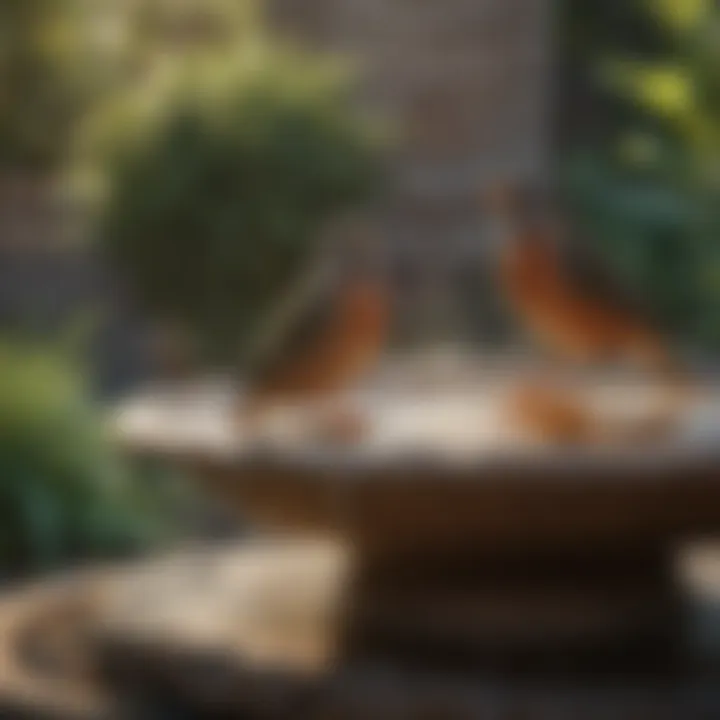
The color choices available for ceramic solar bird bath fountains are as varied as their designs. The glazing process enhances these colors, allowing for hues that can pop against the green landscape or blend in harmoniously. Bright blues and greens might attract attention, while earth tones could offer a more understated elegance, providing a calming effect in the garden.
The appeal of glazes extends beyond just color; they also add texture and depth to the ceramic surface. A shine or matte finish creates different vibes—glossy glazes might glimmer under the sunlight, enhancing a playful garden atmosphere, while matte finishes can evoke a sense of tranquility. Importantly, this variety isn't just about aesthetics; choosing the right glaze can also influence the fountain's resilience and ease of cleaning.
Cultural Influences on Design
Cultural influences play a significant role in shaping the designs of ceramic solar bird bath fountains, reflecting a rich history of artistic expression. For instance, Asian-inspired designs often emphasize harmony and balance, utilizing elements such as asymmetrical shapes and natural motifs that draw from nature.
In contrast, European styles might incorporate Renaissance or Baroque features with intricate carvings and ornate structures. The melding of cultural aesthetics in these fountains not only celebrates diversity but also allows individuals to connect their personal stories to their garden installations. By selecting a fountain that reflects one's heritage or interests, homeowners can add a narrative aspect to their outdoor spaces, making these fountains more than just decorative items—that surface as conversation starters among visitors.
Ultimately, the aesthetic elements of ceramic solar bird bath fountains create an enchanting backyard environment, inviting wildlife and people alike to pause and admire.
Functional Benefits
Ceramic solar bird bath fountains are not just decorative garden features; they provide several key functional benefits that enhance both your outdoor space and the surrounding environment. Understanding these benefits can help gardeners and homeowners—particularly those who want a harmonious, nature-friendly atmosphere—realize the full potential of these installations.
Water Supply Systems
Water supply systems in ceramic solar bird bath fountains typically incorporate a straightforward yet effective design. These fountains often use a small solar-powered pump to circulate water, mimicking natural springs found in gardens. This is essential for a few reasons:
- Constant Fresh Water: The continuous flow helps keep the water fresh and clean, which can prevent standing water that attracts pests.
- Bird Attraction: Moving water catches the attention of birds more effectively than stagnant water, making your garden a favored spot for avian visitors.
- Low Maintenance: Most systems are designed with ease of use in mind. Homeowners can quickly fill the basin and rely on solar energy to handle the rest. Some models even feature built-in filters that make the upkeep a breeze.
When setting up your fountain, it's important to check the pump specifications. Different pumps have varying capacities and flow rates, and proper placement is necessary for optimal functionality. Siting your fountain in a manner that allows sunlight to hit the solar panel directly will ensure that the pump operates efficiently, promoting a constant water flow and enhancing interaction with wildlife.
Solar Power Efficiency
Solar power efficiency is perhaps the crowning jewel of ceramic solar bird bath fountains. Utilizing solar energy has both ecological and economic advantages. Consider the following points:
- Eco-Friendly Operation: By leveraging sunlight, these systems contribute to a reduction in carbon footprints. Homeowners can enjoy the beauty and tranquility of a birdbath without the environmental impact associated with traditional electric models.
- Cost Effective: The ability to operate without any electricity costs translates into significant savings. There's no need to worry about increasing energy bills, especially during the warmer months when the sun is abundant.
The performance of solar-powered systems does depend on the amount of sunlight available in your garden space. Positioning is crucial; ideally, the fountain should be placed where it receives ample sunlight during the day. Some advancements in solar technology allow for better efficiency in lower light conditions, but it’s best to aim for a location bathed in sunlight for most of the day.
Efficient solar power solutions redefine our approach to outdoor features, blending aesthetics with sustainability.
Wildlife Interaction
The presence of ceramic solar bird bath fountains in outdoor spaces carries significant weight when it comes to wildlife interaction. These fountains do not merely serve as ornamental pieces; they act as vital resources for birds and other creatures, fostering an environment where nature can thrive. The allure of running water, coupled with a safe bathing area, attracts a diverse array of wildlife that can bring life and vibrancy to any garden.
Attracting Birds and Other Wildlife
Birds are opportunistic beings, and their interest in our gardens can be greatly piqued by the addition of a ceramic solar bird bath fountain. The shimmering surface of water, especially under the warm glow of sunlight, creates a magnet for the winged visitors. When setting up these fountains, it’s crucial to consider these elements:
- Location: Place the fountain in an area where birds can access it easily while feeling safe from predators. Ideally, a spot near shrubs or trees can provide a dual advantage.
- Water Movement: Moving water is naturally appealing. The gentle trickle from a fountain can entice not just birds but also butterflies and other pollinators.
- Height and Design: A shallow basin allows smaller birds to bathe without the risk of drowning. Decorative edges and varied levels provide perches for birds to rest.
By integrating these features, your garden transforms into a veritable sanctuary for birds looking for a refreshing dip or a place to drink. The flutter of wings and the melodic chirping create an auditory backdrop, enhancing the overall ambiance.
Impact on Local Ecosystems
Establishing a ceramic solar bird bath fountain significantly uplifts local ecosystems. The ecological advantages are substantial, helping to forge a symbiotic relationship between humanity and the wildlife around us. Here are some critical impacts to consider:
- Biodiversity: Attracting various species of birds encourages higher biodiversity in your garden. Different birds not only bring various aesthetics but also contribute to pest control, helping to maintain the balance of the ecosystem.
- Pollination: Many birds are crucial pollinators. By bringing them into your garden, you may notice more fruits, flowers, and other plants thriving.
- Educational Opportunities: These interactive installations serve as educational tools that allow families, especially children, to learn about wildlife and the importance of environmental conservation.
"Simply adding a water source can tilt the scales of biology in your favor, turning an ordinary garden into an extraordinary habitat."
In summary, the role of ceramic solar bird bath fountains extends beyond mere aesthetic appeal. They act as lifelines and catalysts for interacting with local wildlife, enriching our gardens while simultaneously promoting ecosystem health.
Installation Considerations
When it comes to installing a ceramic solar bird bath fountain, thoughtful planning is essential. The right installation can enhance not only the functionality of the fountain but also its role as a centerpiece in your outdoor space. Three key areas to focus on include site selection, setting up the fountain itself, and its ongoing maintenance and care. Each plays a crucial role in ensuring that your fountain stays operational and looking its best for years to come.
Site Selection
Choosing the right spot for your ceramic solar bird bath fountain is no easy feat, yet it is paramount for success. Ideally, you want a location that gets sufficient sunlight throughout the day. Solar fountains rely on sunlight to operate efficiently, and a shaded spot can lead to lackluster water flow, leading to a disappointing experience.
Naturally, look for a flat area where the ground is stable to avoid unsightly tilting or washing away of the surrounding soil over time. Also, consider how close you want your fountain to be to vegetation, as plants can cast shadows and even obstruct solar panels when they start growing.
Additional Factors to Keep in Mind:
- Visibility: Position your fountain in a way that makes it easy to observe birds drinking or bathing. This could be near a seating area or a window.
- Accessibility for Maintenance: Make sure you can easily reach your fountain for tasks like cleaning or refilling.
- Avoiding Debris: Stay clear of trees or areas where leaves frequently fall, as this will reduce the maintenance burden in the long run.
Setting Up the Fountain
Once you have the perfect site picked out, the next phase is setting up the fountain itself. While many ceramic solar bird bath fountains come with clear instructions, the process is straightforward enough that you don’t need to be a DIY expert.
Begin by placing the fountain on the chosen base, ensuring it sits evenly. Secure the solar panel where it receives maximum sun exposure. Some models may have attached panels which can be adjusted for optimal positioning while others will have separate bases. Make sure the water source is connected and that the pump is fully submerged.
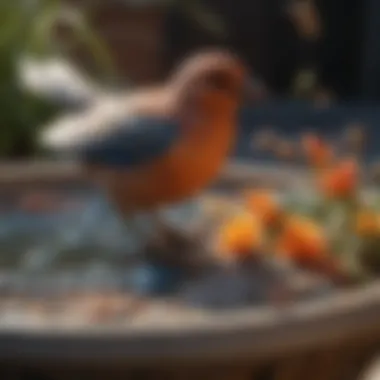
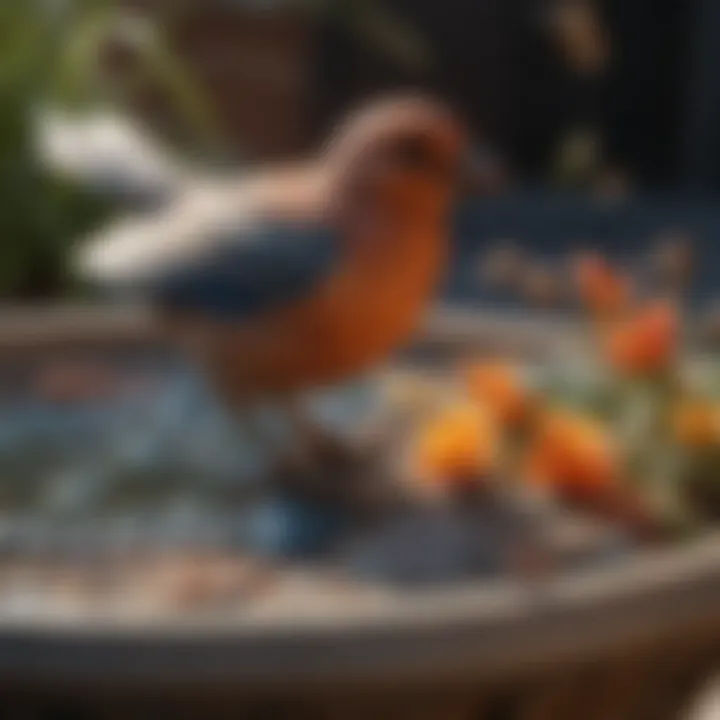
After everything is in its place, you should fill the fountain with water. By doing this, test the pump to ensure it operates as intended. A few tips to remember during setup are:
- Observe the flow of water. Adjust the pump's position if needed to create an appealing water display.
- Some fountains may require a break-in period, so allow it to run for a while before making any final adjustments to the orientation of the solar panel.
Maintenance and Care
After you've installed your ceramic solar bird bath fountain, regular maintenance is key to its longevity and aesthetic appeal. Without care, a beautiful fountain can quickly become a sad mess.
Here are some important maintenance tasks you should consider:
- Water Level: Check the water level frequently. Birds will tend to drink and splash around, causing evaporation. Refill as needed to keep the pump submerged.
- Cleaning: Regularly clean the fountain to prevent algae growth and debris accumulation. Plan for deep cleaning at least once a month, removing stains or buildup. A simple scrub with vinegar can work wonders.
- Seasonal Prep: If you live in a region with cold winters, consider winterizing your fountain. This can include draining the water and protecting it from freezing temperatures.
"A well-maintained fountain not only serves its purpose but elevates the entire garden experience, attracting both birds and admiring guests alike."
To wrap it up, proper installation, care, and selection are not just chores; they are the foundation of enjoying a ceramic solar bird bath fountain. As such, attention to detail is the hallmark of successful garden enhancements.
Environmental Considerations
When delving into the world of ceramic solar bird bath fountains, their impact on the environment cannot be overlooked. As homeowners search for ways to beautify their gardens, it’s also essential to consider the ecological implications of these installations. Not only do they serve as a lovely centerpiece, but they also contribute positively to the environment in various ways. This section will investigate the sustainability of the materials used in these fountains and highlight water conservation practices that make them an eco-friendly choice.
Sustainability of Materials
Ceramic is often lauded for its durability and aesthetic appeal, yet it’s the sustainability of the materials that truly sets it apart in the realm of bird bath fountains. Natural clay, which is the primary component of these fountains, is an abundant resource, contributing to its environmental friendliness. Unlike plastic or metal constructions that may leach harmful substances into the soil, ceramic is generally inert and safe.
Moreover, many manufacturers are increasingly adopting sustainable practices while producing ceramic fountains. This incorporates using eco-friendly glazes and natural pigments, cutting down on volatile organic compounds (VOCs). With the right choice of materials, these fountains can last for many years, promoting sustainability not just in their creation but also in their long-term usage. This approach aligns neatly with a growing societal push towards eco-conscious living.
"When selecting ceramic solar bird bath fountains, look for options marked as eco-friendly or made from recycled materials to ensure the least environmental impact."
Water Conservation Practices
In a world where water scarcity is becoming more pressing, water conservation is a top priority. Ceramic solar bird bath fountains excel in this arena, utilizing solar power to pump water efficiently. This mechanism allows for a continuous cycle of water, which helps in keeping the water clean and reduces evaporation, an issue particularly relevant in warmer climates.
Implementing a bird bath fountain integrated with a drip irrigation system not only beautifies your garden but also conserves water. Homeowners can adapt their fountains to collect rainwater, redirecting it back into the basin. This not only cuts down on the need for municipal water but also supports local wildlife by ensuring they have access to a consistent water source.
In essence, ceramic solar bird bath fountains serve as a merger of beauty and functionality, providing a serene addition to your garden while playing a role in environmental stewardship through sustainable materials and water conservation techniques.
Comparative Analysis
When diving into the world of ceramic solar bird bath fountains, the notion of comparative analysis is significant. It allows potential buyers to weigh their options effectively, understanding the distinct characteristics that set ceramic fountains apart from their peers. This in-depth examination helps in clarifying which choice aligns with individual preferences, needs, and the unique environment one might be enhancing.
Ceramic vs. Other Materials
Ceramic bird bath fountains stand out markedly when compared to alternatives like metal, plastic, or concrete. The first appealing aspect of ceramics is undoubtedly their aesthetic versatility. While metal may rust over time, or plastic can fade and crack under the sun, ceramic possesses a resilience that retains its beauty through various weather conditions. The range of designs is expansive—from intricate hand-painted patterns to sleek modern shapes, ceramics can easily complement any garden style.
Another factor to consider is heat resistance. Ceramic can endure high temperatures without warping or fading, unlike plastic which might soften. Consider this: a porcelain bird bath left in the sun will keep its form and color unbroken, ensuring your garden looks vibrant all year round. The durability of ceramic significantly contributes to its long-term value, making it a worthy investment.
However, ceramics are not without drawbacks. They can be heavier than plastic options, which may complicate installation and mobility. They’re also prone to chipping if not handled carefully—an angle to keep in mind if you live in bustling households with kids or pets around. In the grand scheme of things, while ceramics hold a strong position against other materials, the choice ultimately boils down to personal preference and lifestyle.
Solar vs. Electric Models
In recent years, choosing between solar and electric bird bath fountains has become a hot topic for garden enthusiasts. Solar-powered fountains bring numerous advantages; foremost among them is the environmental consideration. By harnessing the sun's energy, these models reduce electrical dependency, thus benefiting the ecosystem. Additionally, the absence of cords and plugs simplifies installation. They can be placed almost anywhere sunlight doth shine, freeing one from the constraints of wiring.
Electric fountains, on the other hand, provide reliably consistent water flow, a consideration particularly relevant during cloudy days or in shaded areas where sunlight is scant. This can be a game-changer for those aiming to attract wildlife while ensuring movement and sound consistently to keep their garden lively. Yet, the reliance on electric power introduces concerns regarding energy costs and potential hazards associated with water and electricity.
Cost is another dimension worth mentioning. While solar fountains might have a higher initial price, they often pay for themselves with reduced energy costs over time. Comparatively, electric variants may seem cheaper upfront but could lead to additional expenses long-term due to electricity consumption.
In essence, the choice between ceramic solar bird bath fountains and electric models must be pondered thoughtfully, considering factors like usability, preferences surrounding sustainability, and the environment in which the fountain will reside. Whether you favor the elegance of ceramics or the practicality of solar, each option brings its own set of benefits and considerations that contribute to your outdoor oasis.
Enhancing Outdoor Spaces
Creating a welcoming outdoor environment goes beyond mere aesthetics. Ceramic solar bird bath fountains play a crucial role in enhancing outdoor spaces, providing both beauty and function. These installations serve multiple purposes, from creating a serene oasis to attracting wildlife and improving the overall ambiance of a garden. They can even become a focal point, drawing the eye and setting the tone for your outdoor decor.
Garden Integration Techniques
Integrating a ceramic solar bird bath fountain into a garden requires some forethought. Finding the right spot is essential. Positioning the fountain in a visible location can maximize its impact. Consider placing it near seating areas or pathways to allow easy viewing. Tall plants or decorative stones can help to frame the fountain, guiding the gaze of visitors toward this eye-catching piece.
Here are some practical techniques to consider:
- Strategic Placement: Set the fountain in a way where both birds and humans can easily enjoy it. A central spot amidst flower beds can enhance visibility.
- Surrounding Elements: Use plants that thrive in wet conditions around the fountain. Hostas or ferns work well and can help create a lush atmosphere.
- Layering Heights: Arrange other garden features, like garden sculptures or trellises, at different heights to create a visually dynamic environment.
By meticulously choosing where and how to place your bird bath fountain, you can create a more inviting space.
Complementing Landscape Design
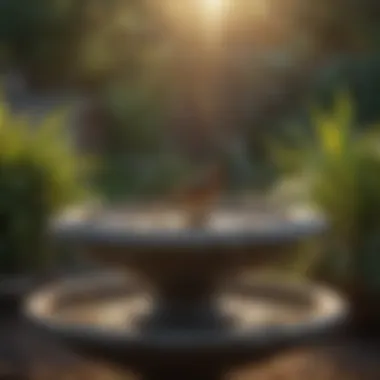
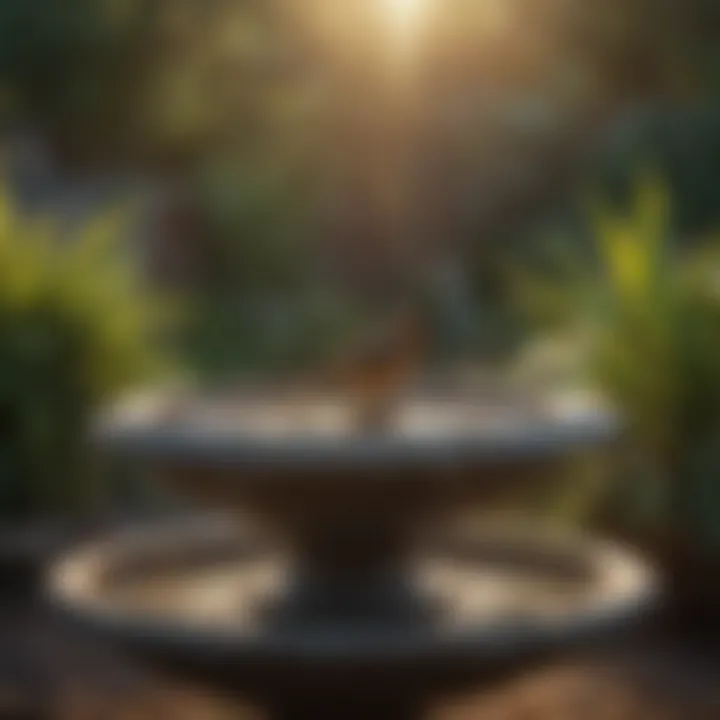
A ceramic solar bird bath fountain should harmonize with your overall landscape design rather than disrupt it. The styles, colors, and textures employed in the fountain can either enhance or clash with existing elements in your garden. Therefore, taking the time to match these aspects can create a cohesive environment.
- Style Compatibility: If your garden leans toward a rustic look, opt for earth-tone fountains with an aged patina. Meanwhile, sleek, modern designs could work well in minimalist landscapes.
- Color Coordination: Consider the hues of surrounding flowers and plants. A blue or green ceramic fountain can tie in nicely with a garden rich in foliage, while brighter colors can serve as a striking contrast against greens.
- Functional Flow: Ensure that the water feature doesn’t obstruct traffic flow. It should subtly enhance the garden layout while allowing seamless movement.
By being intentional about these aspects, the ceramic solar bird bath fountain can elevate your outdoor space, making it not just a place for relaxation but an experience that resonates with nature and design.
Economic Factors
In the context of ceramic solar bird bath fountains, understanding the economic factors is paramount for potential buyers. It goes beyond mere aesthetics or functionality; it's about the overall value these installations provide in both the short and long term. By considering these factors, homeowners can make an informed decision that aligns with their budget while enhancing their outdoor sanctuary.
Cost Analysis of Ceramic Fountains
When diving into the financial aspects, one first encounters the upfront costs involved in purchasing a ceramic solar bird bath fountain. These costs vary widely based on design, size, and brand. High-quality ceramic fountains tend to have a higher price tag due to their craftsmanship and durability. However, including transport and installation fees can add on additional expenses.
Here's a breakdown of some typical costs:
- Small ceramic fountains: $50 - $100
- Medium-sized fountains: $100 - $300
- Large, intricate designs: $300 - $1,000 or more
It's important to keep in mind that cheaper options might not always stand the test of time or weather elements, so investing a bit more can lead to greater satisfaction.
Also, annual maintenance should not be overlooked. Factors like winterization, cleaning, and potential repairs can add to the total cost. Higher quality fountains generally require less maintenance, which can save money in the long run.
Long-Term Value and Durability
Ceramic solar bird bath fountains are renowned not just for their beauty but for their durability over time. When one carefully chooses a model made with high-quality ceramic materials, it translates to fewer replacements and repairs down the line. Such durability is vital for homeowners who want an investment that holds its value through changing seasons.
Moreover, these fountains often come with warranties or guarantees, providing an extra layer of security for your investment. When shopping, it's worthwhile to look into:
- Quality of Material: Higher quality ceramics tend to resist fading and cracking better than their lower-quality counterparts.
- Warranty Coverage: Some brands offer extensive warranties, indicating confidence in their product.
- Community Reviews: Checking out platforms like Reddit or Facebook for user experiences can shed light on which products stand the test of time.
The beauty of a ceramic solar bird bath fountain lies not only in its initial appeal but in the joy it brings versus the cost over time.
Lastly, consider the added benefit of attracting wildlife, which can enhance your property's value indirectly. A well-maintained garden attracts more birds, which can be a selling point for potential buyers. So, it's safe to say that the enduring appeal of these fountains extends well beyond what meets the eye.
Personalization Options
Personalization options for ceramic solar bird bath fountains play a significant role in their appeal and integration into outdoor spaces. For homeowners and garden enthusiasts, these elements not only contribute aesthetic value but also cater to individual preferences and lifestyle needs. With countless designs, colors, and styles available, the ability to tailor a fountain to complement the unique character of a garden transforms it from a mere ornament into a cherished focal point that resonates with the homeowner’s personal taste.
Customization possibilities can range from selecting specific colors to designing unique shapes that evoke personal memories or emotions. Such uniqueness enhances the emotional connection between the owner and the garden, creating a sanctuary that reflects their personality and style.
Custom Designs and Styles
Custom designs and styles are where creativity meets functionality, allowing a ceramic solar bird bath fountain to stand out while serving its purpose effectively. There’s an array of styles available—rustic, modern, whimsical, or classic—that you can choose from, making it easier to find a fountain that speaks to your sensibilities.
When considering custom designs, it’s essential to explore several aspects:
- Material choice: Different types of ceramics can offer varied textures and finishes. For instance, hand-painted designs often elevate aesthetics, while sleek-glazed options provide a more contemporary look.
- Shape and size: Some prefer large, dramatic fountains as statement pieces, while others may opt for smaller, understated models that blend into the landscape seamlessly.
- Theme consistency: A fountain should harmonize with the existing garden decor and landscape theme. For a natural setting, a fountain shaped like a leaf or flower may be fitting, while a geometric design can provide a modern contrast.
In summary, choosing a custom design not only enhances the visual appeal but also enriches the entire garden experience.
Adapting to Personal Taste
Adapting a ceramic solar bird bath fountain to personal taste is about making sure that each element aligns perfectly with the homeowner's vision. This is where the fun and creative process begins. Perhaps you have fond memories of a childhood garden; replicating that feeling can be achieved through colors and designs that invoke nostalgia.
Here are some considerations to keep in mind when adapting your fountain to personal taste:
- Color schemes: Reflect on the hues present in your garden. Are there vibrant flowers that you’d like to echo in your fountain? Matching the color of the fountain with the flowers or foliage around it can create a cohesive visual narrative.
- Functionality vs. aesthetics: While it’s important to choose a visually appealing fountain, don’t forget about its primary role. For instance, if attracting specific types of birds is the aim, consider designs that cater to their preferences. Additionally, fountains with deeper basins may appeal more to larger birds.
- Personal symbols: Incorporating shapes or motifs that have personal significance can create a one-of-a-kind piece that will be treasured for years. Whether it's a pattern reflecting your heritage or a design that represents your family's journey, personalizing in this way adds depth to your garden.
Ultimately, adapting a fountain to personal taste results in a space that is not just visually appealing but also an extension of the homeowner's identity—a true reflection of individuality amid the beauty of nature.
Personalization makes a garden a reflection of the owner's soul, turning an ordinary outdoor space into a remarkable sanctuary.
Final Thoughts
In considering the vast realm of ceramic solar bird bath fountains, it becomes clear that these artistic installations are more than mere decorations; they serve as a bridge between nature and nurtured gardens. The concluding reflections guide us to appreciate not only their aesthetic charm but also their numerous functional advantages that enhance our gardens and support local wildlife. With the insights presented in this article, it's evident that these fountains offer a slew of benefits, from attracting avian visitors to contributing positively to environmental sustainability.
Reflecting on Benefits
Ceramic solar bird bath fountains emerge as standout features in outdoor decor, providing a myriad of benefits worth contemplating. One can emphasize their role in encouraging biodiversity, as they create a welcoming habitat for birds and beneficial insects. The gentle sound of trickling water can turn any yard into a serene sanctuary. Additionally, by employing solar power, these fountains promote energy efficiency, reducing reliance on traditional energy sources.
Moreover, their unique designs and rich glazes offer endless personalization options—ensuring each individual can find a style that resonates with their taste and complements their space. Owning such a fountain can be likened to having a piece of art that simultaneously elevates the home environment and fosters a sense of tranquility.
"A well-placed bird bath fountain can transform a mundane garden into a vibrant ecosystem."
Future Trends in Garden Decor
Looking ahead, the world of garden decor is poised for exciting trends, particularly concerning ceramic solar bird bath fountains. A growing focus on sustainability will likely push more homeowners towards eco-friendly choices. Expect to see an increase in custom designs made from recycled materials, blending creativity with environmental responsibility.
Smart technology will also make its way into future designs. Imagine solar fountains equipped with sensors that adjust water flow based on weather conditions, or even those that collect rainwater for reuse. Furthermore, we can anticipate an array of color innovations and artistic patterns inspired by current design movements, embracing natural aesthetics and organic themes.
In closing, as gardens evolve into spaces for relaxation and biodiversity, ceramic solar bird bath fountains stand out as timeless pieces worthy of consideration. They encapsulate the fusion of beauty, function, and sustainability, positioning them well for a prominent role in future outdoor decoration.















